Below are the Dominant 7 arpeggios on the A string.
Dominant 7 Arpeggio A String
Dominant 7 Arpeggio A String #2
We hope you enjoyed this lesson. If you have any questions or comments you can contact us at patrice@paliatsky.com
Below are the Dominant 7 arpeggios on the A string.

Dominant 7 Arpeggio A String
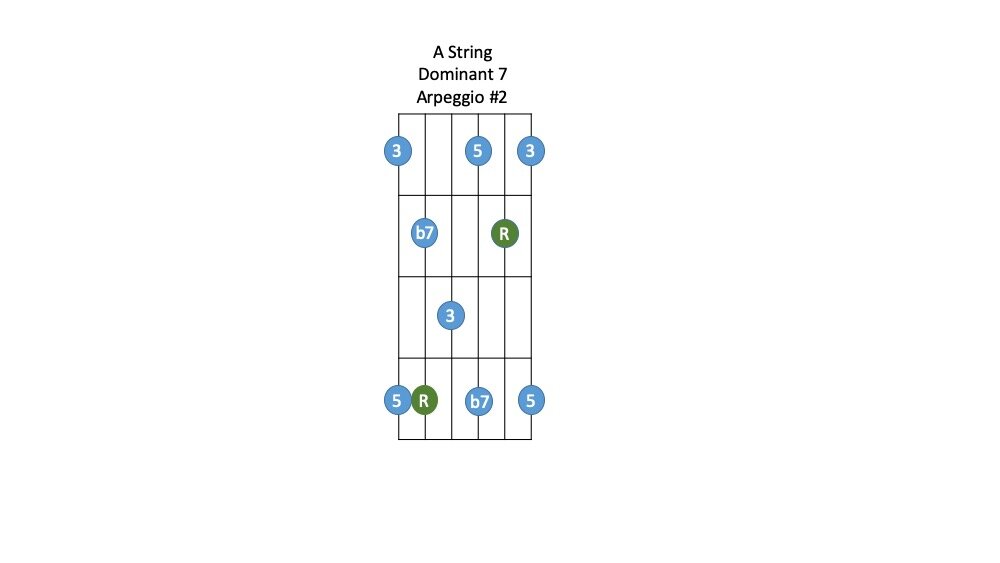
Dominant 7 Arpeggio A String #2
We hope you enjoyed this lesson. If you have any questions or comments you can contact us at patrice@paliatsky.com
Below are the Dominant 7 arpeggios on the E string

Dominant 7 Arpeggio E String

Dominant 7 Arpeggio E String #2
We hope you enjoyed this lesson. If you have any questions or comments you can contact us at patrice@paliatsky.com
Below are the Major 7th arpeggios on the A String

Major 7 Arpeggio A String

Major 7 Arpeggio A String #2
We hope you enjoyed this lesson. If you have any questions or comments you can contact us at patrice@paliatsky.com
Below are the Major 7th arpeggios on the E string.

Major 7 Arpeggio E String

Major 7 Arpeggio E String #2
We hope you enjoyed this lesson. If you have any questions or comments you can contact us at patrice@paliatsky.com
Below are the Minor Maj7 Arpeggios on the A String

Minor Maj7 Arpeggio A String

Minor Maj7 Arpeggio A String #2
We hope you enjoyed this lesson. If you have any questions or comments you can contact us at patrice@paliatsky.com
Below are the Minor Maj7 Arpeggios on the E string.

Minor Maj7 Arpeggio E String

Minor Maj7 Arpeggio E String #2
We hope you enjoyed this lesson. If you have any questions or comments you can contact us at patrice@paliatsky.com
Below are the two minor 7 arpeggios on the E string. Note that this one is almost exactly the same as a Minor Pentatonic Scale Position 4, it’s only missing the 4th.

Minor 7 Arpeggio A string

Minor 7 Arpeggio A string #2
We hope you enjoyed this lesson. If you have any questions or comments you can contact us at patrice@paliatsky.com
Below are the two minor 7 arpeggios on the E string. Note that this one is almost exactly the same as a Minor Pentatonic Scale, it’s only missing the 4th.

Minor 7 Arpeggio E String

Minor 7 Arpeggio on E string #2
We hope you enjoyed this lesson. If you have any questions or comments you can contact us at patrice@paliatsky.com
Here is a classic minor arpeggio on the A string. An Arpeggio is a chord broken down into notes in one area of the neck. They are used for solos, melodies and I use them as finger exercises for pointing and flattening my fingers; if there are notes that are played on the same fret, but a different string, you should be pointing for the lower note and flattening your finger for the higher note. You do the reverse when you go back down.
If you need more information about what an arpeggio is, you should check out our lesson on Chords .

Minor Arpeggio A String
This is a less well know arpeggio, but just as useful.

Minor Arpeggio A String #2
We hope you enjoyed this lesson. If you have any questions or comments you can contact us at patrice@paliatsky.com
Here is a classic minor arpeggio on the E string. An Arpeggio is a chord broken down into notes in one area of the neck. They are used for solos, melodies and I use them as finger exercises for pointing and flattening my fingers; if there are notes that are played on the same fret, but a different string, you should be pointing for the lower note and flattening your finger for the higher note. You do the reverse when you go back down.
If you need more information about what an arpeggio is, you should check out our lesson on Chords .

Minor Arpeggio E String
This is a less well know arpeggio, but just as useful.

Minor Arpeggio E String #2
We hope you enjoyed this lesson. If you have any questions or comments you can contact us at patrice@paliatsky.com
Here is a classic major arpeggio on the A string. An Arpeggio is a chord broken down into notes in one area of the neck. They are used for solos, melodies and I use them as finger exercises for pointing and flattening my fingers; if there are notes that are played on the same fret, but a different string, you should be pointing for the lower note and flattening your finger for the higher note. You do the reverse when you go back down.
If you need more information about what an arpeggio is, you should check out our lesson on Chords .

Major Arpeggio A String
This is a less well know arpeggio, but just as useful.

Major Arpeggio A String #2
We hope you enjoyed this lesson. If you have any questions or comments you can contact us at patrice@paliatsky.com
Here is a classic major arpeggio on the E string. An Arpeggio is a chord broken down into notes in one area of the neck. They are used for solos, melodies and I use them as finger exercises for pointing and flattening my fingers; if there are notes that are played on the same fret, but a different string, you should be pointing for the lower note and flattening your finger for the higher note. You do the reverse when you go back down.
If you need more information about what an arpeggio is, you should check out our lesson on Chords .

Major Arpeggio E String
This is a less well know arpeggio, but just as useful.

Major Arpeggio E String #2
We hope you enjoyed this lesson. If you have any questions or comments you can contact us at patrice@paliatsky.com
This is a great fingerpicking song. It’s quite challenging. Harry Chapin uses his first finger to sweep over a few strings at a time. I wrote the sheet in a way that replicates this but it’s not exact, as when he sweeps with his finger he doesn’t always hit the same strings. After the bridge, he plays with more intensity, so you could strum instead of doing the fingerpicking, but either way works. Harry himself played it differently live. Watch out for the odd time signatures and the repeat signs.

Harry Chapin - Cats in the Cradle P1

Harry Chapin - Cats in the Cradle P2
We hope you enjoyed this lesson. If you have any questions or comments you can contact us at patrice@paliatsky.com
Pay attention to the variations on the chords played, as they require to plan your fingering in advance. Most of the chords are triads. The Sheet below is for one of the guitars only.

The Strokes - Why Are Sundays So Depressing P1
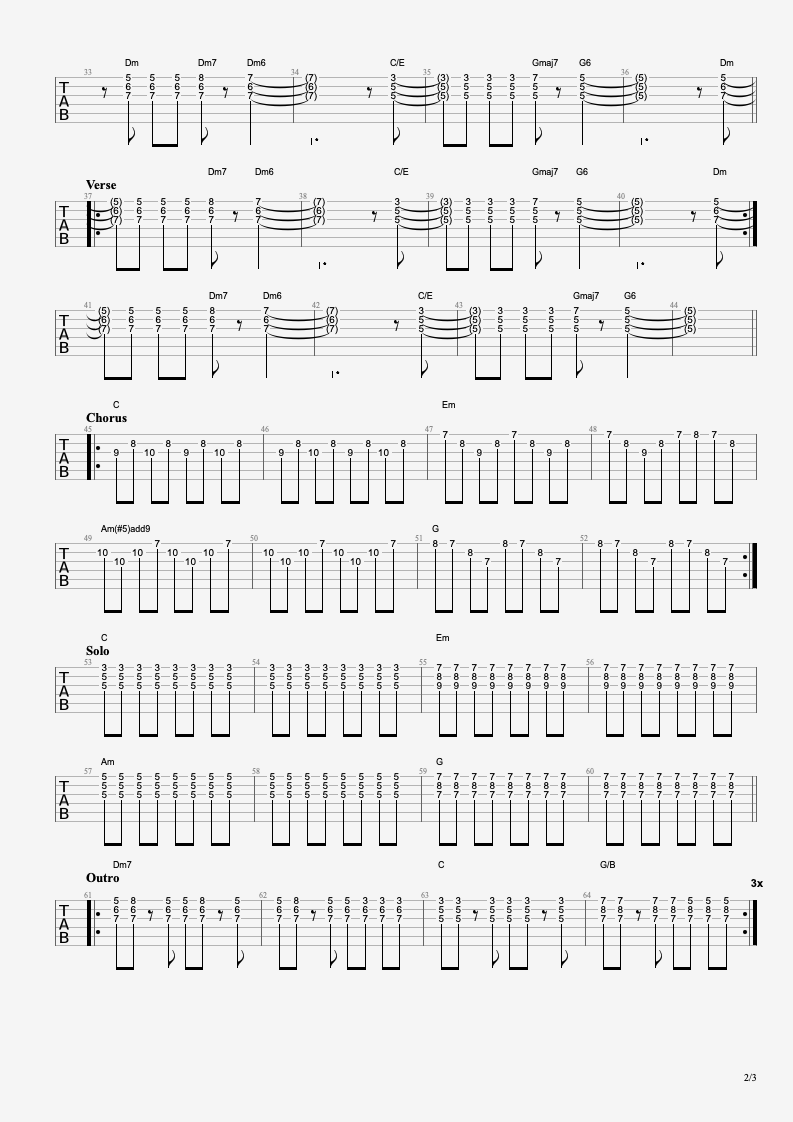
The Strokes - Why Are Sundays So Depressing P2

The Strokes - Why Are Sundays So Depressing P3
We hope you enjoyed this lesson. If you have any questions or comments you can contact us at patrice@paliatsky.com
This is a good fingerpicking song, pretty straight forward. There are a few variations in the second chorus that are not indicated in this music sheet.

Harry Styles - Sweet Creature P1

Harry Styles - Sweet Creature P2
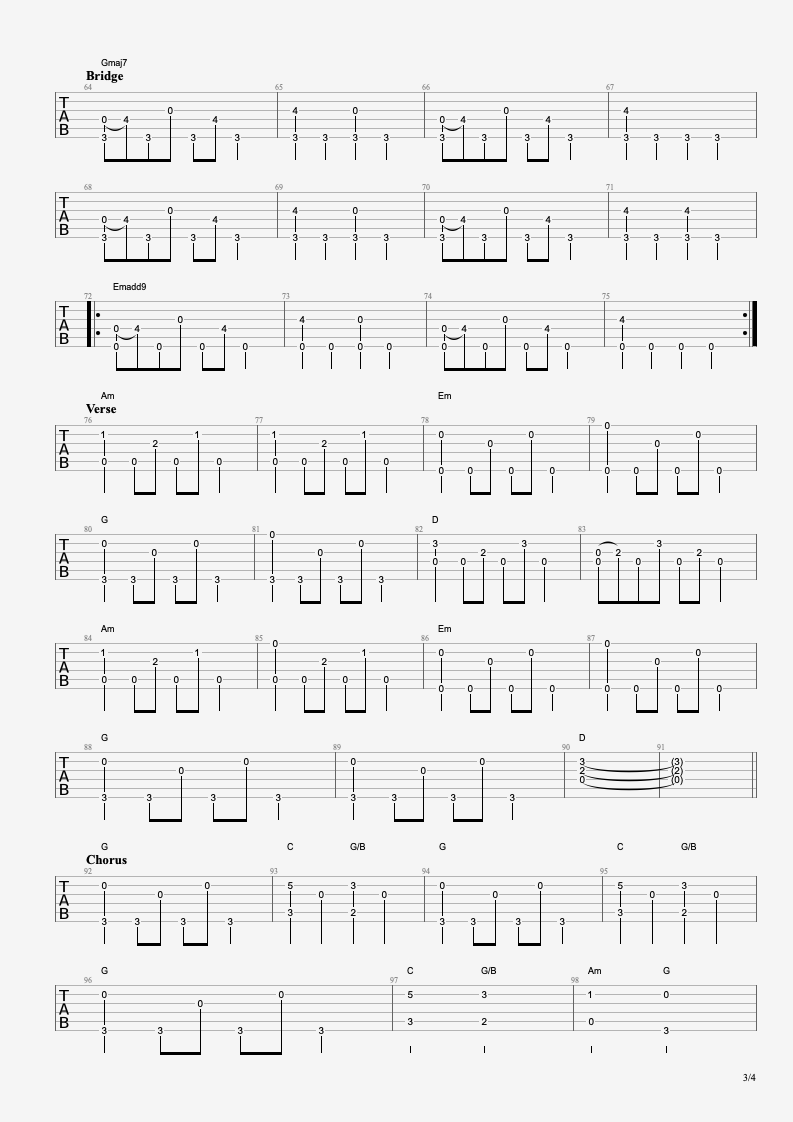
Harry Styles - Sweet Creature P3

Harry Styles - Sweet Creature P4
We hope you enjoyed this lesson. If you have any questions or comments you can contact us at patrice@paliatsky.com
The notes of the Blues scale can be found everywhere on the neck of the guitar. Therefor, there are positions to help you remember where the notes are.
Below is a graphic showing what the Blues scale positions looks like on the guitar. The green colour is the root note. So, you simply need to find the root note for the key signature you are playing in and start the scale from there. The Orange note is the blue note.
Position 2 starts on the second note of position 1; position 3 starts on the second note of position 2, etc. Each position is connected with the following one, position 5 being connected with position 1.

Blues Scale Positions Guitar
We hope you enjoyed this lesson. If you have any questions or comments you can contact us at patrice@paliatsky.com
The Blues scale is a variation to the Minor Pentatonic scale. It has all the same notes :1, b3, 4, 5, b7; but it also has a #4 or b5 which gives it a very powerful sound. The blue note is a great passing tone note, meaning that it’s not a note to focus on too much during a solo, but it is great to add a little spice to your improvisations.

Blues Scale Guitar
We hope you enjoyed this lesson. If you have any questions or comments you can contact us at patrice@paliatsky.com
This song has a great solo and a catchy riff that is harder to play than it seems. During the chorus, you’ll need to stretch your fingers quite a bit.

The Beatles - Bulldog P1

The Beatles - Bulldog P2
We hope you enjoyed this lesson. If you have any questions or comments you can contact us at patrice@paliatsky.com
This is a really good song to learn fingerpicking. The intro starts the song with a challenge, but the verse and chorus and bridge are harder to play, so it gradually becomes more difficult as the song progresses.
In the intro, the chords go as follow:
C, Cmaj7, Cadd9, C; Asus2, Asus4, Am, Asus2; Cadd9, Cmaj7, C, Cadd9; Am, Asus4, Asus2, Am.
It seems complicated but what it means is that you keep all your fingers on the same fret for 4 measures at a time, but changing the notes on the B string. So, on the chord of C you play with your first finger on the B string first fret, then without it for Cmaj7, then add your pinky for Cadd9, back to first finger for C. You do the same thing for the Am chords for 4 measures.
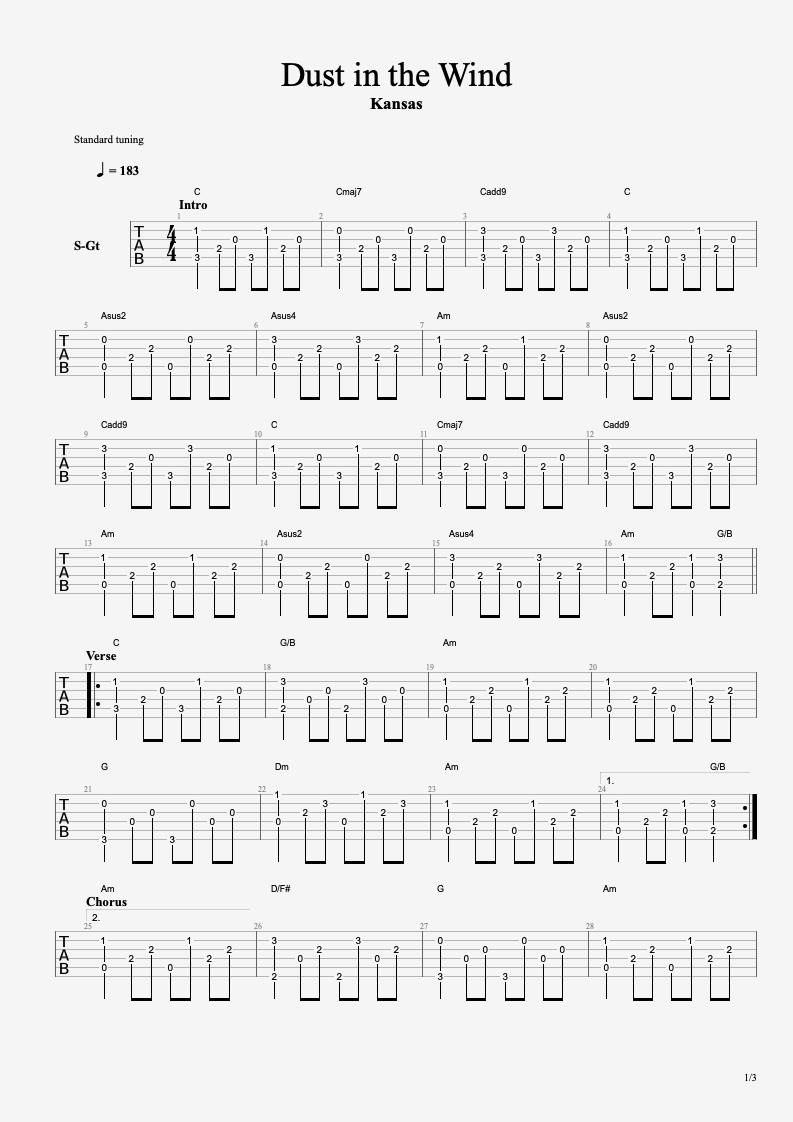
Kansas - Dust in the Wind P1

Kansas - Dust in the Wind P2

Kansas - Dust in the Wind P3
We hope you enjoyed this lesson. If you have any questions or comments you can contact us at patrice@paliatsky.com
This song is pretty simple. In the recording it is hard to hear the guitar that does the chords, because the bass is doubled by a guitar, but in the live recordings you can see billy joe playing chords. You can find the bass part here: Green Day - Warning Bass
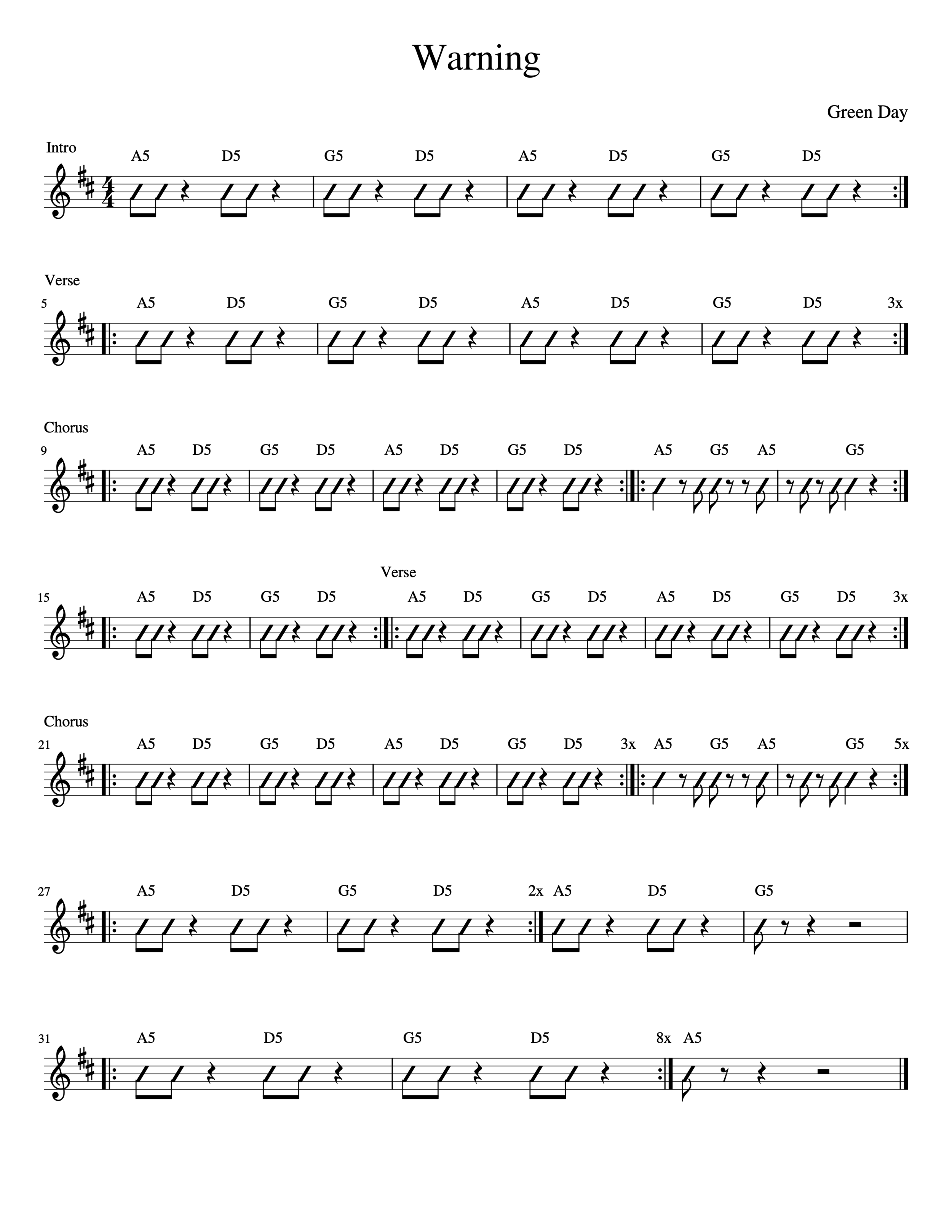
Green Day - Warning Lead Sheet
We hope you enjoyed this lesson. If you have any questions or comments you can contact us at patrice@paliatsky.com